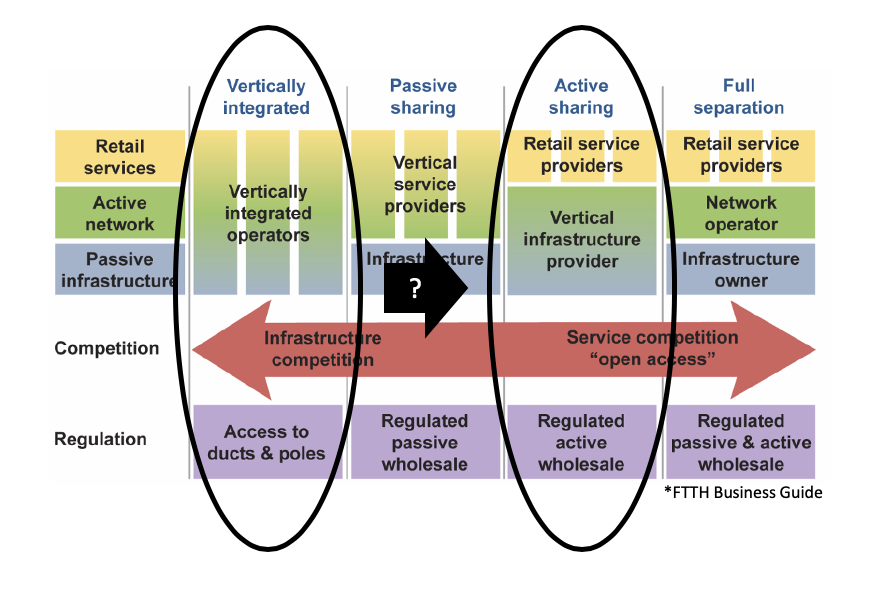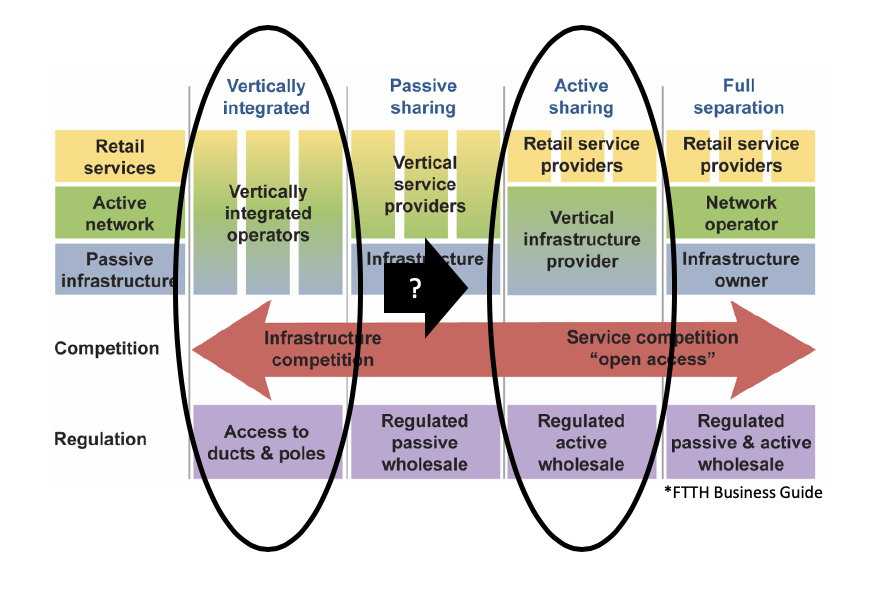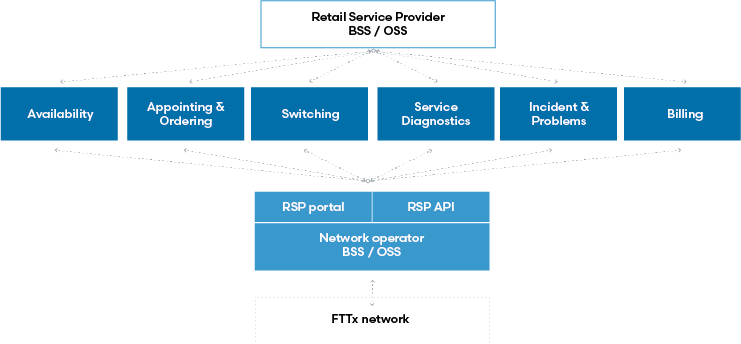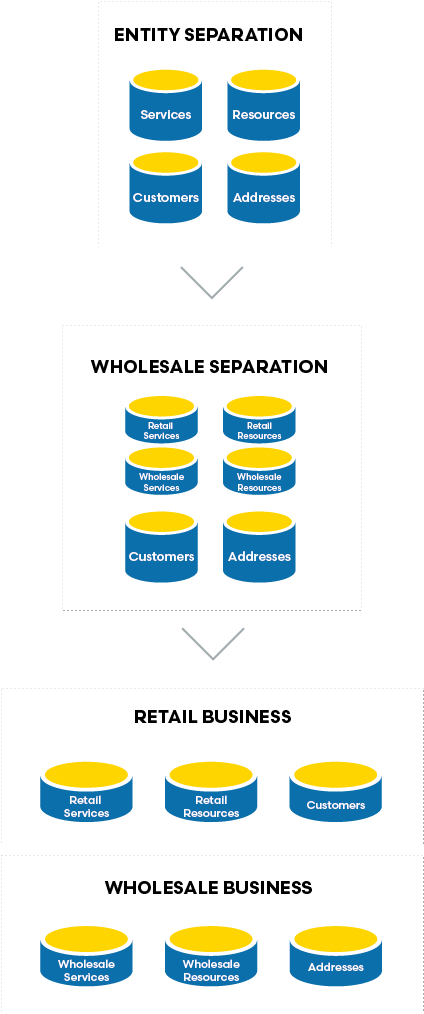3 min read
How to make the transition from a vertically integrated fiber business to a Wholesale/Open Access business
Netadmin Content Creator
:
Jun 8, 2020 4:14:00 PM

In this article, we will explain how to achieve a successful transition from a vertically integrated business to a wholesale/open access business, based on our customers’ experiences.
Many fiber operators are either already doing wholesale, in the process of building a wholesale business or aiming to reach wholesale sometime in the future. We’ve seen that this change becomes harder the longer your business stays vertically integrated, thus it is important to prepare for the shift to wholesale as early as possible.

For many operators, the first question they ask themselves is why they need to prepare for wholesale in the first place? Isn’t it just another offering for another set of products in the existing portfolio? We have found that viewing wholesale as simply another offering can cause many problems. It is important to see it as a completely new and different business since it is so distinct from the standard retailing. Not only does it differ in the type of investments and the type of customers that you normally work with, but also, more importantly, from the software side, there are many different processes and ways to implement these processes.
Traditional business processes, like marketing, sales, delivery, order journeys, assurance, and billing, involve both the retailing and the wholesale parts, making interoperability between these two parties crucial.
To achieve interoperability between the retail service provider (RSP) and the operator, splitting is often mentioned, and it can have various meanings. On the one hand, it can mean doing a completely functional separation and spinning out the retail business as a separate company. On the other hand, it can also become a business unit within the same company. What we have found is that splitting retail and wholesale to some extent is a good idea. However, splitting a vertically integrated business without proper preparations can be both complex and costly.
Three areas of preparation
While interviewing some of our customers that have gone through the journey to wholesale from being vertically integrated, we found three areas that contain essential elements to consider when preparing for the shift.
- Customer journey
- Interoperability
- Data migration
Customer journey

Often operators claim that if you are planning to move towards wholesale, you do not have to engage with or care about the end-customer. While this is true to a certain extent, the customer experience heavily relies on the retail service provider and the wholesale service that is provided to the retailer.
Netadmin believes that it is even more important to think about end-customers if you are wholesaling. The experience and the whole business case, for the involved parties, rely on good collaboration. The term customer journey is a great tool to use to make sure the experience for the end-customer runs smoothly regardless if you are retailing or wholesaling. Therefore, we recommend wholesalers, together with the retailer, to think about and map out the end-customer experience and thus collaborate smartly.
Interoperability
One way of achieving a good collaboration is having good interoperability between the different parties. On the top is the retail service provider having either an operational support system (OSS) or a business support system (BSS). At the bottom, we have the network operators who have their systems and procedures. In between these two actors are six key interoperability areas relevant to building up automation around.

Six key areas: Availability, Appointing & Ordering, Switching, Service Diagnostics, Incidents & Problems, and Billing.
Availability entails informing the retailing provider that you are rolling out in a new area, thus updating the availability.
Appointing and Ordering refers to automating the scheduling of engineers and appointing and ordering an installation.
Switching is crucial and is intertwined with the wholesale, meaning the process of switching from one provider to another would require automation between the retailer and the wholesaler.
Service diagnostics involves allowing retail service products to troubleshoot customers themselves as well as identifying incidents and problems. Furthermore, it will enable the retail service to do revenue assurance, which makes billing a vital area.
In conclusion, to have a good collaboration between parties as well as creating an excellent customer experience, you need a high level of interoperability around these six areas. While many different solutions for success exists, a solution that Netadmin has found in different countries is to create a platform that connects everything and manages the interoperability.
Interoperability between network operators and service providers - How to make your business grow in an Open Access network
Data migration
Data migration might not be the most exciting preparation step but highly important. We have seen several operators that have tried for several years to split the data from a vertically integrated system landscape without any success. To assist in this process, Netadmin has concluded three steps to take towards separation in terms of managing data in your system.
Most operators have four different entities in their support system: the services they provide, resources that make up these services, customers, and locations where they deliver services or addresses, including your PRN.

Netadmin recommends, based on experience from our customers who have undergone this journey, to create a split of the data layer before you split the business layer. This entails dividing the service catalog into a wholesale part and a retail part to prepare once you separate the retail and the wholesale business.
Similarly, split the resources and distinguish which resources are owned and should be owned by which side of the company. That is where the split is recommended to be.
By doing the splitting of service and resources, it becomes easier to conduct the final step. In this step, the retail services, retail resources, and customer data are wholly owned by the retail business, whereas the wholesale business owns the wholesale services, wholesale resources, and addresses.
To conclude, this is a high level of data migration journey that Netadmin has found to be successful if you have any data from vertically integrated business and want to handle it when you are splitting into retail and a wholesale component.







